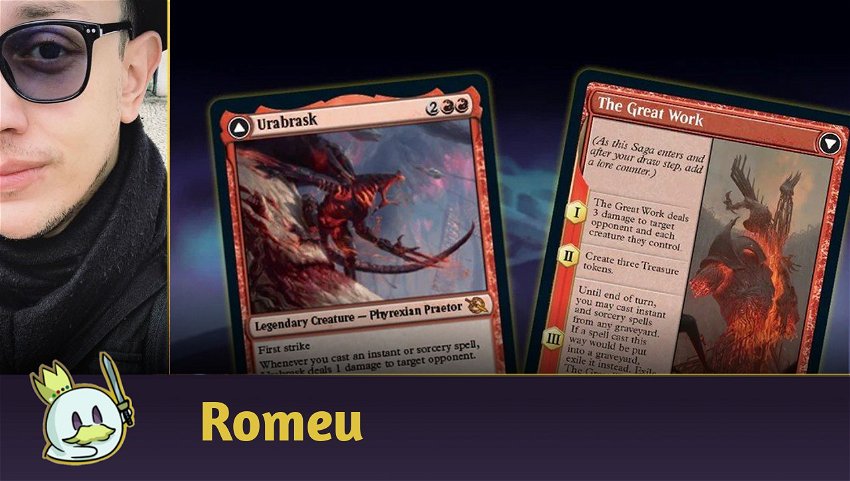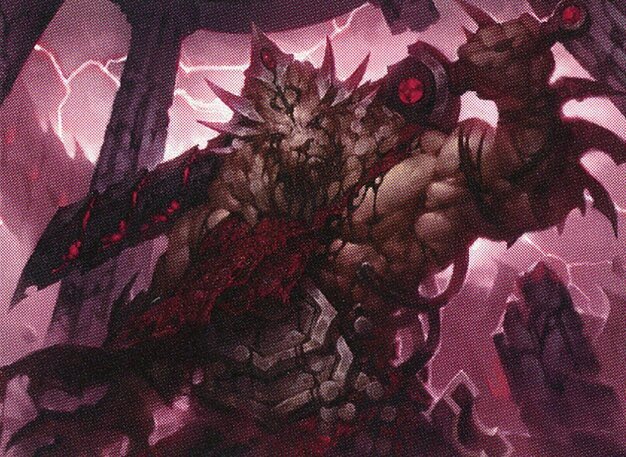The March of the Machine preview season has been in full swing since last week. And with it comes the hype season, where players and influencers get really excited about certain cards as they're revealed.

The latest hype revolves around Urabrask. The red praetor was the worst of the cycle in its previous two iterations, but now, Wizards seems to be giving it the proper treatment.
There are several comments on the social media about how the new Urabrask is absurd in the right build, and works as a wincondition and recurring free mana in a single card - almost the dream of any Storm player. On the other hand, there are also those who claim that it will not be as absurd as it seems due to its high mana cost and low immediate impact without other cards to play alongside it.
In theory, both sides are accurate. But in my review, I'll show how the praetor has flaws which hinder its space in the competitive scene.
Urabrask - The Review

4/4 Creatures for four mana with keywords in red is nothing new, and even in March of the Machine, we already have the presence of another spoiler with the same pattern, with Rampaging Raptor. In that regard, Urabrask would already have plenty of competition for slots in all competitive formats and wouldn't stand out due to how poorly it trades with Sheoldred, the Apocalypse in Standard and Pioneer, as well as having way better options in Modern and Legacy.
But the point of interest for players in the praetor is its second set of abilities, where it lowers the cost of your Instants and Sorceries by adding a red mana every time you cast them, and still turns them into recurring damage sources. That is, Urabrask is a Storm engine with a built-in wincondition.
The creature also has its transformation into The Great Work, where its first chapter is a sweeper, the second works as ramp, and its third is a pseudo-Past in Flames to all graveyards, in addition to returning the original face to the battlefield to restart the Storm cycle.
From a game design perspective, Urabrask is very well-designed: he plays around himself, with a set of abilities that allow him to restart his transformation with every cycle, and has a decent body to survive against different creatures.
On the other hand, it doesn't operate on its own and requires some dedication and resources to get the most out of it, and it rewards its controller with a sweeper against small creatures when common sense is that, for an Aggro to beat combo decks, their best route is to extend the board and go for the race.

As a creature, Urabrask doesn't compete well with a high range of four-mana threats: Sheoldred, the Apocalypse, Thundering Raiju, Esika's Chariot, and Crackling Drake are superior to the Praetor in their respective decks in Standard and Pioneer, and the cost efficiency on Modern and Legacy is too high for it.

Its true potential would be in the combo engine function, where we sequence various spells to take advantage of its triggers, just like we do with Birgi, God of Storytelling.
Unlike the Kaladesh goddess, though, the praetor doesn't trigger with any spell, and requires a higher deckbuilding restriction to play around it, as well as not generating infinite combos with Grinning Ignus. Its high mana cost also becomes an issue when you want to squeeze the most value the turn you cast it.
Urabrask in Standard

Standard still lives in a Metagame where Midranges are at the top while Aggro decks try to play under them. In this environment, where answers are plentiful, and sequencing spells also depends on the number of resources on the opponent's board and the efficiency of their mana colors, Urabrask doesn't seem to have a home.

It doesn't seem to fit in either a more aggressive Mono-Red shell with Monastery Swiftspear and low-cost spells, or a classic Control that abuses Big Score and other Instants to stall the game and sequence spells with Arcane Bombardment or Mindsplicer Apparatus, as it doesn't offer any immediate impact or actively collaborate with what these archetypes propose.
Unlike other praetors such as Elesh Norn, Urabrask will need a new archetype to take its place in Standard, preferably with good access to low-cost spells that replace themselves in the hand and/or that don't need legal targets to work. It also needs a less hostile Metagame for creatures that don't pose an immediate threat.
Urabrask in Pioneer
On Pioneer, the red praetor has support that allows it to transform faster:

And since Urabrask deals damage to the opponent, it also triggers Light up the Stage, in addition to interacting well with Bedlam Reveler and Reckless Impulse

And of course, we can run it alongside Birgi, God of Storytelling to squeeze more value out of your spells, or even as a decent four-drop in a Mono Red Phoenix list, which also received the new Bloodfeather Phoenix.

If we look at other colors and/or intend to abuse its other side, we have Ichormoon Gauntlet and Flux Channeler to proliferate The Great Work's counters, in addition to Experimental Augury and spells that generate Treasure to sequence long turns. We may even include Prologue to Phyresis to accelerate our wincondition.

The problem is that Urabrask's creature side is mostly a glorified Storm-Kiln Artist, and leaves it far from being as viable as Pioneer, since it doesn't interact well with the main competitive archetypes that care about sequencing spells in a single turn, such as Izzet Phoenix and Lotus Combo.
Urabrask in Modern

Storm is a well-known archetype in Modern since its early days. Despite being out of favor in the Metagame since Modern Horizons, the deck still has many enthusiasts interested in putting it back on the radar.

Urabrask's direct comparison in the format is to cost reducers and Birgi, who often play in this archetype. In this case, it loses space on the list due to its high and restrictive cost, which doesn't facilitate the combo, nor does it offer immediate value, unlike Birgi's other side, which grants a recurring card advantage on the combo turn.

Another possibility would be to replace the Grapeshot slots, which would greatly increase the need to sequence spells in a single turn: in traditional Storm, you can win the game with nine spells and two copies of Grapeshot for 21 damage. With Urabrask, you'd need to cast a number of spells equal to your opponent's life total after the praetor comes into play, which would already cost four mana to start with.

A fairer comparison with the praetor would be with Venerated Rotpriest and the strategy known as Poison Storm*, where you need a creature on the battlefield to establish your win condition. But unlike Vorinclex's minion, Urabrask requires a very high mana investment, thus slowing down the combo.
Urabrask in Legacy
Legacy is the only format where Urabrask has some potential, as there is an archetype ready for it, and which the card seems to be tailor-made.
The Relay Storm is a Legacy deck that makes occasional results in tournaments. It is focused on a red shell which takes advantage of Birgi, God of Storytelling to generate mana and close the game with a spell from the Sideboard, fetched with Burning Wish.
There are several variants of this deck: some with more lands, others with Ruby Medallion and rituals, such as Seething Song, among other options. And instead of competing with Birgi, Urabrask can complement her.

But an overhaul of the shell that makes up the archetype to expand the number of spells and reduce the number of permanents would be necessary, as they don't trigger its ability. Also, in a strategy where players try to end the game with Tendrils of Agony, there doesn't seem to be room to overextend the spell sequencing in a single turn without a Galvanic Relay backup.
On the other hand, three damage is a relevant number in Legacy, and kills many important creatures in the current Metagame. On a Galvanic Relay turn, transforming Urabrask at the end of the process can ensure that your next turn will come against a full board and/or with a few pesky threats, such as Delver of Secrets and Dragon's Rage Channeler, and the Treasures generated in the next draw step will help extend the combo and generate the right mana for Tendrils of Agony and/or Echo of Eons.
Conclusion
Despite having powerful abilities and generating a lot of value in the long term, Urabrask lacks space in most competitive formats due to its restrictive cost. Four mana is a high price to pay for an engine that needs several other parts to function, and the fact that it's a creature makes it an easy target for disruption at inopportune times.
The best space for him in the competitive scene today may be Legacy, where means of generating absurd mana early are legal, and his saga abilities allow good setups alongside Galvanic Relay in Storm decks.
As for the other formats, it will need more support in the future to establish its own archetypes that can have it as a main win condition.
Thanks for reading!













— Comments 0
, Reactions 1
Be the first to comment